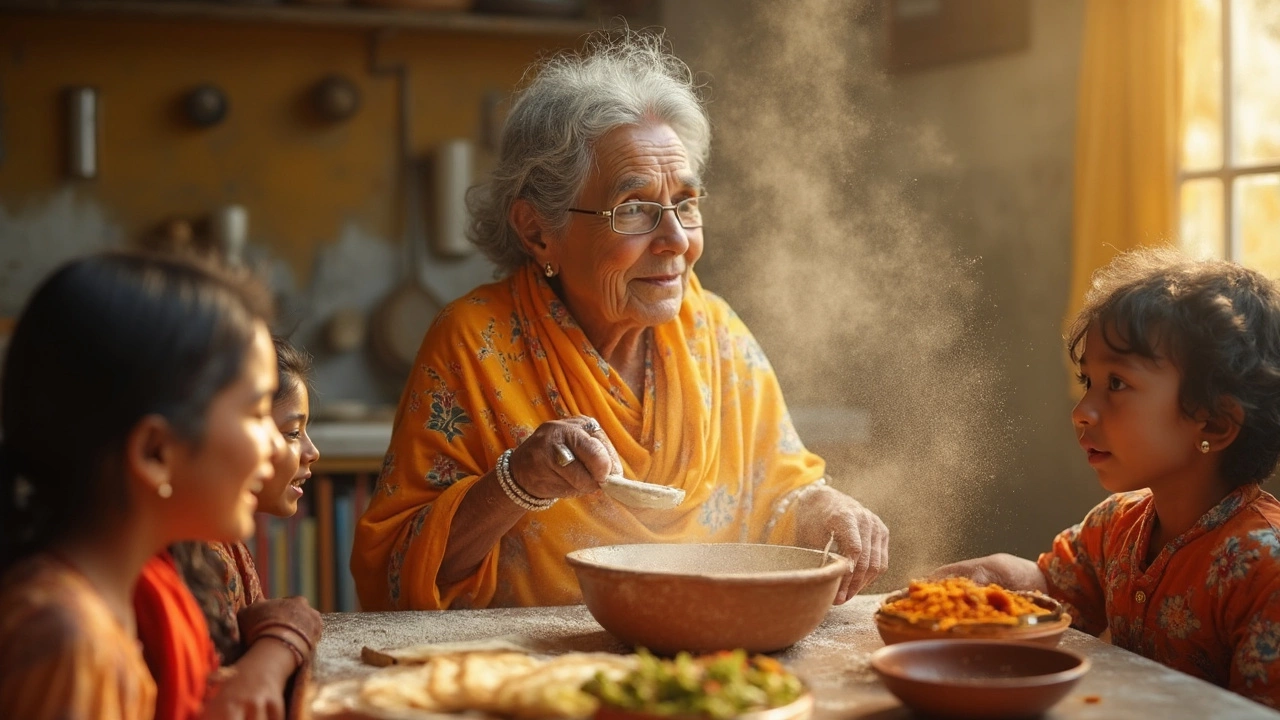How Many Chapatis Should You Eat in a Day? A Guide to Balanced Nutrition
 Feb, 24 2025
Feb, 24 2025
Ever wonder how many chapatis should be on your plate daily? You're not alone. This question pops up in Indian households all the time. A balanced diet doesn't come with a one-size-fits-all answer—it's all about your unique needs.
First, let's talk about calories. That's the energy your body gets from what you eat and drink. To figure out how many chapatis you can enjoy each day, you must consider how many calories you need. Ever hear of Body Mass Index (BMI)? It's a handy tool for understanding if you're underweight, healthy, or need to shed some kilos. Dive into the world of calorie calculators online; they make it easy to plug in details like age, weight, and activity level to get your daily calorie needs.
- Understanding Calories and Nutritional Needs
- Calculating Your Perfect Chapati Count
- Legal Guidelines on Nutrition
- Local Dietary Practices and Tips
Understanding Calories and Nutritional Needs
Alright, let's get down to basics about calories. They're the little units of energy that keep our bodies going. In India, chapatis are a staple, and if you're wondering how they fit into your daily needs, you're in the right place.
Why Calories Matter
Think of calories as fuel. Your body needs a certain amount every day to do everything from breathing to running marathons. Undereating can leave you sluggish, while overeating might pack on the pounds.
So how do you know your magic number? This is where a calorie calculator comes into play! Find one online, pop in your age, weight, height, and activity level, and voila—it'll tell you how many calories you should be consuming.
Chapatis and Their Caloric Content
Let's bring chapatis into the picture. An average chapati, or roti, packs in around 70-80 calories. This can vary slightly depending on size and ingredients (like ghee). So when planning your meals, you must factor in the calories in one roti alongside other foods.
| Chapati Size | Calories |
|---|---|
| Small | 70 |
| Medium | 80 |
| Large | 100 |
But it's not just about calories. Each chapati also provides carbohydrates, fiber, and some protein, making it a key piece of the nutritional puzzle.
Legal and Local Perspectives
In India, the government doesn't set strict legal standards for daily nutritional intake. However, there's a common guideline followed called the 'Recommended Dietary Allowance' (RDA). While it's not a law, it's a respected benchmark for planning meals.
Locally, diets vary widely, so cultural and individual preferences play a huge role. Many dieticians in Mumbai advise personalizing your intake around traditional meals, ensuring you get all nutrients—not just calories.
- Step 1: Calculate your daily caloric needs with a calorie calculator.
- Step 2: Identify how many calories you get from foods like chapatis (remember, calories in one roti).
- Step 3: Balance your daily meals according to these findings and make room for preferences.
Calculating Your Perfect Chapati Count
So, you're ready to figure out how many chapatis you should eat. Let's break it down step by step, keeping it simple and practical.
Step 1: Know Your Caloric Needs
First things first: hop onto a calorie calculator. Enter your height, weight, age, and activity level. It’ll tell you how many calories you need per day. Remember, someone who’s active will need more fuel than a couch potato.
Step 2: Understand Chapati Calories
One plain chapati, also known as one roti, packs about 70 calories. This can vary a bit depending on size and ingredients, but it's a good average.
Step 3: Consider Your Meal Plan
Suppose your daily needs are about 2000 calories. Your meals should balance protein, carbs, and fats. If chapatis are your main carb source, allocate around 400-600 calories for them. That equals roughly 6-8 chapatis a day.
Step 4: Factor in Your BMI
Don't overlook your Body Mass Index (BMI). If it suggests you should lose weight, reduce your chapati count a bit. Monitoring your BMI ensures you stay on track health-wise.
The Role of Local Eating Habits
In India, chapatis are a staple. Balancing them with veggies, dal, and lean meats helps you keep a varied diet. Don't skimp on fruits and leafy greens either!
Legal Guidelines on Nutrition
Be aware that India’s food laws emphasize transparency in nutrition labeling. It’s legally required to display calorific values on packaged foods, so use this info to make better choices.
- BMI tells you if you’re in a healthy weight range. Check yours often.
- Use a daily calorie calculator to plan meals.
- Mix chapatis with protein and veggies for balance.
With these steps, you can fine-tune how many chapatis you eat in a day to suit your lifestyle. Keep it local and keep it smart!

Legal Guidelines on Nutrition
Nutrition isn't just about preferences—there are some important guidelines to keep in mind. In India, the Food Safety and Standards Authority of India (FSSAI) sets rules for food safety and nutrition labeling. Knowing these can help you make wiser decisions about your diet and calorie calculator results.
FSSAI Nutritional Requirements
FSSAI guidelines recommend daily intake standards for various nutrients, which can vary based on age, gender, and specific health needs. For a balanced diet, they suggest meeting your calorie requirements through a mix of macronutrients: carbohydrates, proteins, and fats.
What’s interesting is the focus on fortifying common foods like wheat flour with iron and folic acid. Since chapatis are a staple, this fortification plays a big role in tackling deficiencies.
Labeling Laws
Ever checked out the info on packaged foods? FSSAI mandates that nutritional labels on food packages must clearly show information about calories and other nutrients. This means understanding the calories in one roti compared to packaged breads is straightforward.
Local Dietary Standards
In Maharashtra and other parts of India, local dietary recommendations from health bodies often stress the importance of balancing traditional foods like chapatis with modern eating trends. This isn't just about health—it's law-supported advice to make sure everyone knows how to keep a healthy BMI.
From a legal standpoint, staying informed about these guidelines isn't just smart—it’s essential for making conscious dietary choices that align with both personal health and national regulations.
Local Dietary Practices and Tips
When it comes to Indian meals, chapatis are as essential as air-conditioning in a Mumbai summer. But how do we fit them into a balanced diet? Let's dive into some practical tips rooted in local customs.
Understanding Portion Sizes
Portion control is key. Most Mumbai households serve chapatis with vegetables, dal, and sometimes a bit of rice. A healthy adult might serve themselves 2-3 chapatis per meal, depending on their BMI and activity level. It's crucial to pair your chapatis with a bounty of veggies. This keeps the meal balanced and ensures you’re not overloading on carbs.
Quality of Ingredients
Often, what you put into your chapatis matters as much as how many you eat. Aim for whole wheat flour. It’s richer in fiber compared to refined flour, so it's better for digestion and keeps you full longer. For an added boost, some people mix their atta with millet or jowar flour.
Legal Guidelines
In India, regulatory bodies like FSSAI (Food Safety and Standards Authority of India) have guidelines for nutrition. Make sure your sources of food, especially grains, meet these safety standards. This helps in ensuring your chapatis are safe and nutritious.
Quick Tips
- Use an online calorie calculator to check how many calories from chapatis fit into your daily needs.
- Alternate between different types of rotis like bajra or jowar to diversify nutrition.
- Monitor how you feel. If you feel sluggish, it might be wise to reassess the number of chapatis you're eating.
Remember, balance is the secret sauce to nutrition. Understanding your own body's needs, which a Body Mass Index (BMI) can help with, sets you on the path to eating right.